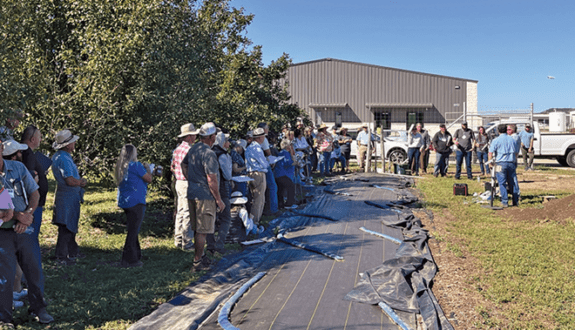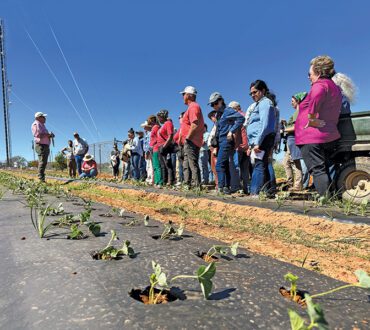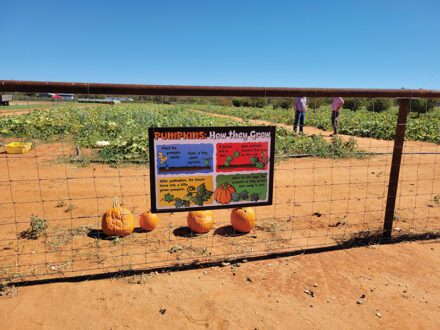

Jan 21, 2024Texas event tailors fruit education to state’s climate
To successfully grow peaches and other tree fruit in the Lone Star State’s challenging climate, growers must carefully consider proper fruit and site
selection and how to establish their orchards.
Participants at the Oct. 18-20 Texas Fruit Conference in Fredericksburg, Texas, received a grounding in how weather events — as well as proper tree selection — can affect production, and steps they must take to grow healthy trees.


Researchers from the Texas A&M AgriLife Extension Service in College Station discussed the myriad of obstacles — as well as opportunities — facing growers.
Monte Nesbitt, Extension program specialist of pecans/ fruit/citrus, described growing conditions in Texas, particularly this year, as “fruit Ground Zero.”
“I’ve been a horticulturist for a long time,” Nesbitt said. “It was rough this year and it’s going to be rough next year and in the year after next, probably different than 2024.”
Many crops cannot grow well in Texas. Walnuts and sweet cherries, for example, aren’t in abundance.
“A lot of people want to grow peaches and want to grow apples, the popular fruit, but, no, you can’t do it,” said Tim Hartmann, assistant professor and Extension
specialist for fruit in Blanco.
Depending on a grower’s location, they can grow apples and peaches, but it will require a lot more work than other fruit. Asian persimmons and European American hybrid pears are much easier to grow in Texas, he said.
After site selection, deciding what to grow is the most important consideration because “it doesn’t matter how good your site is or how good of a job you do taking care of those trees, if you’re not growing the right thing, it doesn’t matter,” Hartmann said.
For many reasons, Texas doesn’t see as much fruit production as other states, including California and Washington.
The top reason, particularly for peaches, is spring frost, which can occur as late as April 7. Add unpredictable weather and temperature variance plus heavy rains and high humidity hitting the wrong times during the growing season.
An orchard may get an afternoon shower during the summer, which didn’t happen much this year. It quickly dries, but a grove receiving a tenth of an inch at night, benefits from wet leaves throughout the night.
“It’s about how long water remains on tree tissues,” Hartmann said. “That’s going to create a lot more problems for disease. We have little orchards typically surrounded by a lot of wild areas, a lot of pastures and a lot of woods, so we have all kinds of insects and pests that are going to keep on coming in.”


Tree selection is vital to orchard establishment. To avoid planting trees containing pests such as the peach tree borer, growers should evaluate their trees before planting, said Larry Stein, professor and Extension horticulturist in Uvalde.
“When you plant trees, you have to start with good trees,” he said. “If you start with a tree that’s not good, then you’re starting way behind the curve. I personally still like bare root trees. You get them from a good nursery and the roots are healed in soil and you see how those roots are covered with soil, you’re not going to have a problem. It’s only when you get them from a nursery that doesn’t take care of their trees that you can run into an issue.”
Stein pointed to a grower who planted bare root trees in March, later than the early January to early February recommendation. The trees are doing well at four to six feet tall.
In discussing site and resource evaluation for new fruit, Jim Kamas, associate professor, Extension fruit specialist and director of the Texas A&M AgriLife Extension Viticulture & Fruit Lab in Fredericksburg, noted the changing Texas peach industry.
In 1996, when he returned to Texas from Cornell University, the state had 3,500 acres of peaches. Today, it’s declined to a third of that.
In the 1990s, many growers with 100-150 acres would pick, pack and truck fruit to the San Antonio terminal market, where if they received $10-$12 a box, 40 to 50 cents a pound, they thought they were doing well.
Many changes have occurred since then, including an aging grower demographic.
“There are only a handful of young people in the business today,” Kamas said. “There are older people behind them, but they’re the next generation that’s coming on and I’m really encouraged to see as many young people in the crowd today interested in growing. It is a wonderful job, but it’s hard, hard work.”


The Pedernales River that flows through the Texas Hill Country produces soils ideal for fruit production. Fruit trees on 12-18 inches of coarse loamy sand benefit from quick drainage, even during heavy rains. That helps oxygen quickly return to the soil after a significant rainfall.
“That’s really important because trees suffering from too little water look exactly the same as the trees suffering from too much water,” Kamas said. “Without both oxygen and water in the root zone, plants can’t take up water or nutrients.”
Plants suffering from drought or too much water show leaves drooping.
“That’s because they’re not getting oxygen from the soil and there’s no uptake,” he said.
Conversely, red sandy clay subsoils have a high water capacity. Some Texas groves this summer received favorable rains in April but suffered a drought the rest of the summer.
“At least there was some water in that subsoil that could maintain plants over a period of time,” Kamas said. “If you didn’t have irrigation on plants this year, many of them died. This gives you the best chance of success, especially for peaches or pears or some of our deeper rooted crops.”
The sessions covered a variety of topics, with sessions dedicated to apples, pears, stone fruit, table grapes, raspberries, figs, olives, disease and ,insect threats, orchard integrated pest management, time management and also included tours of commercial fruit growing operations in the Fredericksburg area.
— Doug Ohlemeier, assistant editor
Top photo: Participants in the conference attend an irrigation workshop. The event also featured sessions on growing fruit tree. Photo courtesy of Larry Stein, Texas A&M AgriLife Extension Service.














